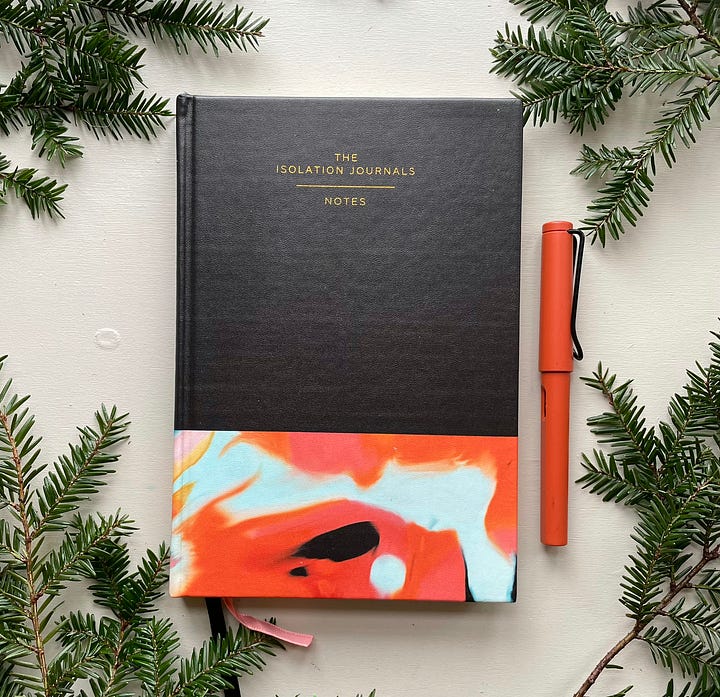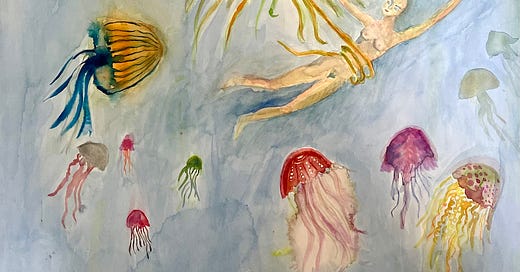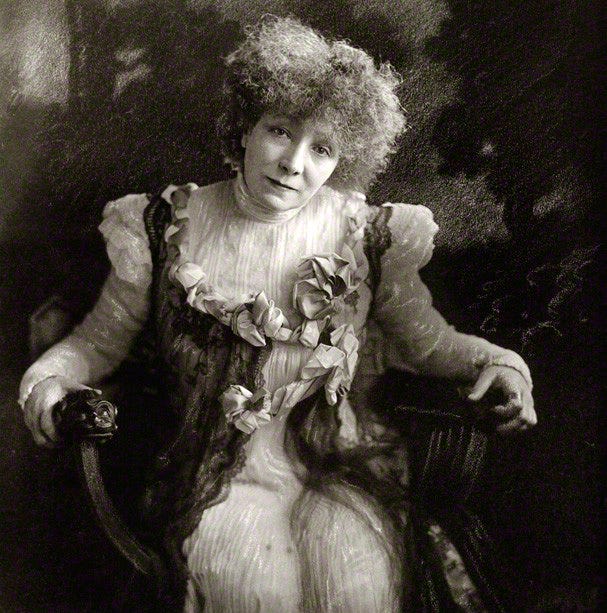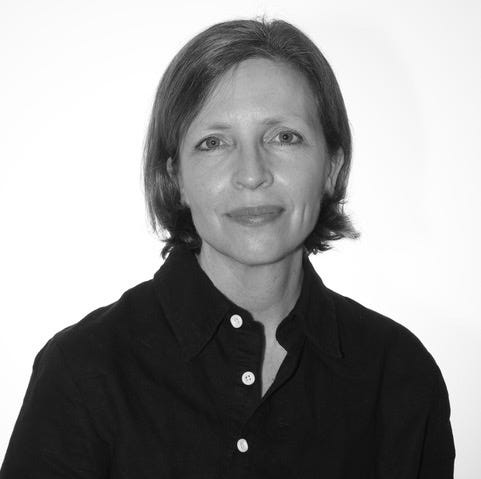Prompt 278. The Immortal Jellyfish & Intuition
& Alex Bertram on the unequivocal magic of the every day
Hi friend,
Can you tell I’ve had jellyfish on the brain?
Since I started painting two years ago, this is how it happens. I have a recurring vision—sometimes from a memory, other times from a dream or nightmare. Sometimes the image appears out of nowhere, as these alien-esque sea creatures did this week. I don’t know where the vision comes from or why it persists, and I often try to ignore it. But if it hangs around, eventually I give in. I let it wash over me. Then I transform it into watercolor.
So this week, I painted jellyfish, and I fell a little bit in love with them. They’re beautiful—translucent, iridescent, even bioluminescent. They seem mysterious and contradictory in that they’re so placid and seemingly peaceful, but also threatening. When I was painting, it wasn’t clear to me how they relate to each other and to the woman in the scene—whether they are friends or foes. But rather than working out what it meant, I tried to remain in a nebulous headspace. As much as I can, I try to create from that place of mystery, to trust that intuitive pull without quite understanding it. Otherwise it’s easy to become prescriptive or narrative in a way that flattens it—that makes it too neat.
It was only after I was finished that I began to see an undercurrent of meaning. When the jellyfish visions began, I had been seized by anxiety about my bone marrow biopsy next week, and I didn’t know what to do with myself. The days leading up to a biopsy feel excruciatingly peaceful. Nothing is happening, there’s no action to be taken, yet I feel a lurking threat. I thought, “That’s what this pre-scanxiety feels like—like the woman floating underwater with these jellyfish.”
The morning after I finished the painting, I started reading about jellyfish, and what I learned was fascinating. Did you know that jellyfish have been billowing through the Earth’s waters for 600 million years? Since before the dinosaurs, before flowers or fungi? That they’ve survived five mass extinctions? They don’t have a brain or heart, just a nervous system (which felt very resonant to me, since I’m all nervous system right now), and they’re incredibly adaptable, existing in every ocean, from the coolest waters of the Arctic to the tropics to freshwater ponds and lakes. A species that fascinated me in particular is called the immortal jellyfish. If something bad happens to it—say it gets hurt, or sick, or even just gets old—it can revert to an earlier stage of development, transforming its own cells so that it goes from its fully grown, sexually mature state back into its fetal form, which is a colony of polyps. From there, it starts over again. It can theoretically do this forever, so scientists consider it biologically immortal.
What did I conclude from this? That I relate to jellyfish, and that I’m fascinated by the subconscious—what appears there, what lingers, how it connects to the events of our lives (or doesn’t). When you allow your intuition to be the thing that leads, there’s a mysterious beauty in the creative process. It feels like magic to create from this place, to look and look and look again, and each time, to find some new facet, a new morsel of meaning. One day I think, “She’s completely ensnared.” The next I note how calm she looks; she and this jellyfish seem to be peacefully coexisting. It’s rich and resonant, and it feels like a mirror for where I am in life, in this liminal state between sick and well. And like some sort of self-designed Rorschach test, I’m open to the fact that it may mean something very different to me a month from now.
The things we create, the magic they hold, and the meaning we make from them is the subject of today’s essay and prompt by the writer Alex Bertram. Evocative and searching, it tells the story of a portrait that took hold of her and wouldn’t let go. To learn why, read on—
Sending love,
Suleika
Some Items of Note—
We’ve scheduled our next meeting of the Hatch, our virtual creative hour for paid subscribers—Sunday, January 28th from 1-2 pm ET. Holly will be hosting this time and sharing about the interplay between community and creative discovery. It’s the most wonderful way to spend an afternoon—I hope you’ll consider joining!
Joy alert! Each Friday in our Isolation Journals Chat, we share our small joys in a chorus of collective gratitude. This week, I shared about my sweet pup Sunshine and her new habit of “booping” and sought the community’s expert advice on what it’s all about. To be buoyed by the joys of others and to add yours too, click here!
If you missed our New Year’s Journaling Challenge—don’t worry! Rumi’s poems and the prompts inspired by them are evergreen, so you can take them up anytime. Maybe tomorrow? Start here.
Prompt 278. Unequivocal Magic by Alex Bertram
There is something about old photographs that I have always found intriguing. In my early twenties, I worked as a picture researcher for a book publisher. Evenings and weekdays merged as I flipped through albums at the state library. I was drawn by what Susan Sontag calls the “equivocal magic” of photographs—“the most mysterious of all the objects that make up, and thicken, the environment we recognize as modern.”
The process of sorting through picture archives became second nature, automatic, but it also trained my eye. Often my reason for selecting a picture was instinctual: I trusted my first impressions. I remember playing around with the images for one book, setting them out on the archival desk as if on the gallery wall, as I tried to work out which two worked together, how much space they needed on either side, if they could carry a double-paged spread, and so on, all the time wondering: If I could find one single thread that united these choices, what would it be? It was, of course, my own game, but a difficult question to answer, nonetheless.
Then, on a more recent visit to the Victoria and Albert Museum in London, I saw a 1910 portrait of Sarah Bernhardt, the famous French actress whose career by then had spanned half a century. We exchanged glances; I was lured in. Her face is pale with the texture of powder. The deep shadows in the backdrop, and small hand-drawn dabs of light, all work hard to hold you there. She sits, dead center, resting her forearms on the chair. Her left index finger, with its band of silver, curls inwards, controlling the tension in the shot.
I found myself beset with questions about this unidealized representation of the actress in her older age, questions that multiplied in the months that followed. They began to bother me, blurring my memory of the library itself. I can’t tell you where I was sitting when I saw it, or how far I could see across the gardens in the courtyard below. My mind was lost in the portrait, and the layers embedded in it. What could it tell me about her? Or about the photographer, H. Walter Barnett, who’d slipped from cultural memory? About the circumstances surrounding the making of the portrait—the before, during, and after?
As I explored its story, I saw that I was drawn to the creativity that’s inherent in all the things we interact with in our day-to-day lives but that we do not see. The portrait’s visual tension, insights, and trickery were all part of the same thing: my enduring interest in the hidden creativity of ordinary things. The revelation helped me to arrange my materials and begin to tell the story of the portrait’s life.
Your prompt for this week:
Think of an object that lured you in—maybe a famous photograph, a family heirloom, a building with a strange history. Write about what you found captivating and why and what it might say about you.
If you’d like, you can post your response to today’s prompt in the comments section, in our Facebook group, or on Instagram by tagging @theisolationjournals. As a reminder, we love seeing your work inspired by the Isolation Journals, but to preserve this as a community space, we request no promotion of outside projects.
Today’s Contributor—
Alex Bertram is fascinated by the relationship between words and pictures. She has worked as an editor, writer, and picture researcher for book and magazine publishers in Melbourne and London and holds a PhD in Creative Writing for her cultural biography of a portrait of Sarah Bernhardt. Alex lives in Victoria, British Columbia, where she works as a creative writing instructor at the University of Victoria and Simon Fraser University.
For more paid subscriber benefits, see—
A New Year’s Journaling Challenge, an evergreen series of six prompts inspired by the ancient wisdom and searing insights of Rumi, designed to help us learn that forever lesson: to hold the cruelty and beauty of life in the same palm
Studio Visit: Hospital Edition, where I gave a behind-the-scenes glimpse of my hospital room turned painting studio and talked about using a creative practice to navigate life’s interruptions
On Hoarding, Grief & Asking for What You Need, an installment of my advice column Dear Susu where I answered a question from a reader whose husband’s hoarding has reached its “ultimate expression” and who is desperate for change


Our Isolation Journal No. 1 and Surrender Tote
We designed a custom Isolation Journal with all our favorite features and a tote embroidered with my favorite mantra to carry it around in. We have limited stock, so if you’d like one, click below!













Thank you for the prompt!
One day when I was journaling, the memory of Lucille came to mind. Lucille was a children’s book about a horse who became a lady, dressing in fine clothes and listening to the radio in the house with the farmer’s wife. Eventually Lucille decided she preferred to be herself and returned to the field alongside the farmer who loved her.
I enjoyed this book so much that when it was time to return it to the library, I hid it under my bed so my mom couldn’t find it.
So much to unpack there…why I was so captivated by this story….and evidence that a desire to get my needs me existed in me at such a young age. And when, I wonder, did we ever return Lucille? Did I ever confess or did it just magically “appear”?
As this memory came up, I realized that thanks to the internet, I had the ability to see if Lucille was available. While I could not check it out from my local library, I found it on a used book site. Three weeks later, a yellow book with tattered spine arrived, and Lucille was mine again.
The girls liked the book; but for me, Lucille held many questions. What about this story was my younger self so drawn to? What made this deep of an impression?
I suppose we all want to be loved and known for our true selves. We all go through periods where we try other personas, wear figurative masks, but the surest way to happiness is just to be ourselves. And find people who love us for this too.
First I would like to express how excited I am about your work, Suleika! I have been observing all along, especially the pieces done at the hospital. My daughter was so quiet during those months on the 8th floor and when I saw your work, I thought this may very well be how Anjelica felt as well, the transfusions, the naked vulnerability, the expression of life, death, nature, dreams and emotions. And the jellyfish, I love how they can be terrible or benign. I recently came across a photo of myself at age 21. A headshot taken by a professor of art and photography at Stamford University. I worked as a waitress in Palo Alto at the time (I was also a student) and he was a customer. He asked if he could take some photos of me and I agreed. Its a sepia finish and my youthful, passionate eyes gaze outward, reminding me how full of life and energy I was, how philosophical and passionate I was then. It was a wonderful reminder of the young woman I used to be. That young woman still lives deep within myself. The photograph also reminds me of how much lust for life I have lost over the years, how much passion has been buried. It has inspired me to dig deep, to reach out and touch that young woman within, full of intense inspiration and creativity, to bring some of that forth into my life today.